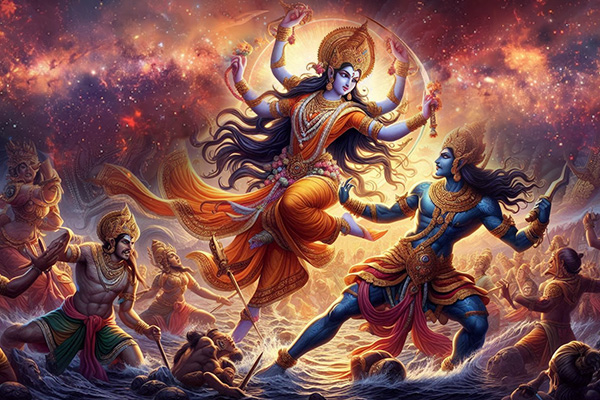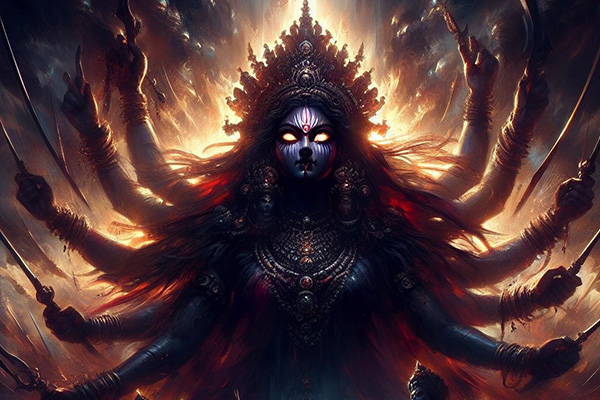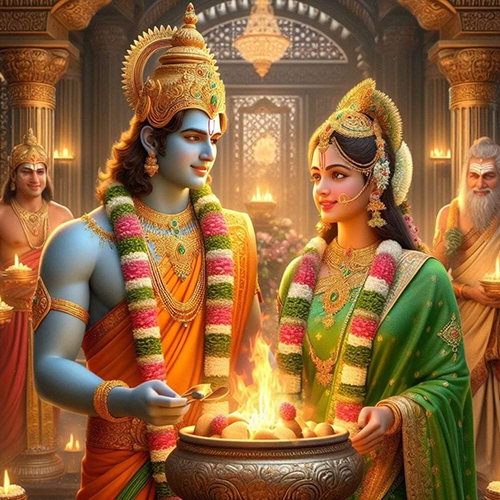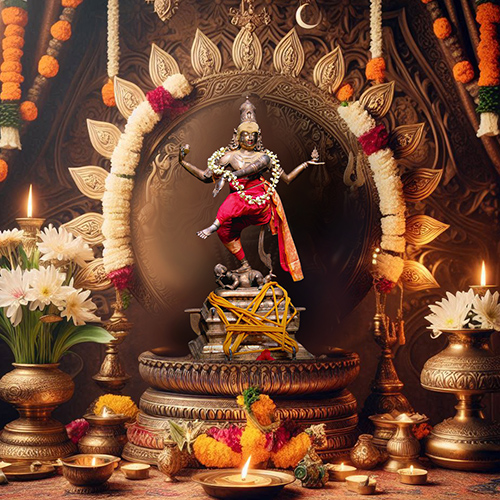-2024.jpg)
Navratri, also known as Durga Puja, is a sacred and cherished festival in India. The ceremonial worship of Goddess Durga in nine different forms over the course of 9 nights is an integral part of this festival, however it is observed differently in different parts of India. One of the most significant and fortunate days dedicated to Goddess Durga is Ashtami Puja, which takes place on the 8th day of the Durga Puja festival. Intricate ceremonies, sincere prayers, and lively celebrations mark this day, which is dedicated to honor the divine feminine energy and to seek her favor.
About Maha Ashtami Durga Puja (Durga Ashtami) 2025:

The eighth day of Navratri, Durga Ashtami, is celebrated with great joy and love all over India. Goddess Durga's fight against evil reached a turning point on this day, when she killed Raktabeej as Kali and then beat the demons Chanda and Munda in her fierce Chamunda form.
Celebrated at the nexus of Ashtami and Navami, the Sandhi Puja honors this change. The Sandhi Puja, which is done when Ashtami and Navami meet, glorifying this change.
A significant part of this day is the Kumari Puja, where young girls are revered as living embodiments of the goddess herself. Just as Durga draws upon the pure, divine feminine power to protect and nurture the world, these young girls represent the untouched potential and innocence that resides in all creation. By offering them fruits, flowers, sweets, and new clothes, devotees honor not only the goddess’s valor but also the essence of feminine divinity that she embodies.
The Kumari Puja is woven into the larger narrative of Durga’s battle—just as she protects and empowers the universe, worshipping young girls symbolizes the nurturing, protective power within every woman. It reflects the belief that Durga’s power resides in every soul, ready to be awakened. Through this ritual, devotees connect with the goddess’s energy, seeking her blessings for strength, purity, and the removal of obstacles, believing that the young girls hold within them the divine spark of Durga herself.
On this day, which is also known as Vira Ashtami in many parts of India, people honor Durga's divine weapons, which stand for her power and bravery.
Many devotees fast on this divine day as Vrat (fast) is a way for devotees to purify themselves and ask the goddess to protect them, remove barriers, and improve their general health.
When Is Durga Ashtami 2025: Durga Ashtami Puja Tithi & Muhurat
Durgashtami on Tuesday, September 30, 2025
Ashtami Tithi Begins - 16:31 on Sep 29, 2025
Ashtami Tithi Ends - 18:06 on Sep 30, 2025
Masik Durgashtami Dates
|
Dates
|
Time
|
|---|---|
|
January 7, 2025, Tuesday
|
Pausha, Shukla Ashtami
|
| Begins - 06:23 PM, Jan 06 | |
|
Ends - 04:26 PM, Jan 07
|
|
|
February 5, 2025, Wednesday
|
Magha, Shukla Ashtami
|
|
Begins - 02:30 AM, Feb 05
|
|
|
Ends - 12:35 AM, Feb 06
|
|
|
March 7, 2025, Friday
|
Phalguna, Shukla Ashtami
|
|
Begins - 10:50 AM, Mar 06
|
|
|
Ends - 09:18 AM, Mar 07
|
|
|
April 5, 2025, Saturday
|
Chaitra, Shukla Ashtami
|
|
Begins - 08:12 PM, Apr 04
|
|
|
Ends - 07:26 PM, Apr 05
|
|
|
May 5, 2025, Monday
|
Vaishakha, Shukla Ashtami
|
|
Begins - 07:18 AM, May 04
|
|
|
Ends - 07:35 AM, May 05
|
|
|
June 3, 2025, Tuesday
|
Jyeshtha, Shukla Ashtami
|
|
Begins - 08:34 PM, Jun 02
|
|
|
Ends - 09:56 PM, Jun 03
|
|
|
|
Ashadha, Shukla Ashtami |
|
July 3, 2025, Thursday
|
Begins - 11:58 AM, Jul 02
|
|
|
Ends - 02:06 PM, Jul 03
|
|
August 1, 2025, Friday
|
Shravana, Shukla Ashtami
|
|
Begins - 04:58 AM, Aug 01
|
|
|
Ends - 07:23 AM, Aug 02
|
|
|
August 31, 2025, Sunday
|
Bhadrapada, Shukla Ashtami
|
|
Begins - 10:46 PM, Aug 30
|
|
|
Ends - 12:57 AM, Sep 01
|
|
|
September 30, 2025, Tuesday
|
Durga Ashtami
|
| Ashwina, Shukla Ashtami | |
|
Begins - 04:31 PM, Sep 29
|
|
|
Ends - 06:06 PM, Sep 30
|
|
|
October 30, 2025, Thursday
|
Kartika, Shukla Ashtami
|
|
Begins - 09:23 AM, Oct 29
|
|
|
Ends - 10:06 AM, Oct 30
|
|
|
November 28, 2025, Friday
|
Margashirsha, Shukla Ashtami
|
|
Begins - 12:29 AM, Nov 28
|
|
|
Ends - 12:15 AM, Nov 29
|
|
|
November 28, 2025, Friday
|
Pausha, Shukla Ashtami
|
|
Begins - 01:09 PM, Dec 27
|
|
|
Ends - 11:59 AM, Dec 28
|
Durga Ashtami Story

In the universe, where good and evil have been constant adversaries, there developed a demon so strong and merciless that even the gods feared in his wake—Mahishasura, the shape-shifting buffalo demon. Driven by a blessing from Lord Brahma, he was unbeatable among Gods & Men. Driven by arrogance, Mahishasura unleashed his wrath, darkening and destroying the three realms. Driven from their own heavenly homes, the sky echoed with the complains of the Gods.
Understanding that only a power stronger than themselves could avert this threat, the Divine Trinity of Brahma, Vishnu, and Mahesh combined their highest energies to create a being unlike any before—Goddess Durga. Glowing in her heavenly majesty, with the combined might and abilities of all the gods, she glowed like a thousand suns, with ten arms holding celestial weapons, a lion as her devoted creature and a heart blazing with righteous wrath.

Durga's arrival's news sent ripples around the planet. Her goal is to wipe the wild demon and bring the universe back into harmony.
It happened during Sharad Navratri, the peak of conflict between the mighty Devi Durga and Mahishasura. The skies saw an epic battle between the forces of light and darkness for nine days and nine evenings. Sneering and sly, Mahishasura sent his most powerful generals to face the goddess.
Among them were the vicious Chanda and Munda and the deceitful demon Raktabeeja whose own blood was a weapon of destruction. He was nearly impossible to kill as every drop that touched the ground created a thousand clones of him.

Raktabeeja's clones multiplied with every Durga's sword blow, the battlefield became an exhibit of mayhem. Maa Durga, nevertheless, remained unfazed.
Durga turned into her most terrible form—Maa Kali, the ferocious goddess of destruction—with a roar that shook the earth. Her tongue licked out in need of vengeance, her eyes burned red with rage, and her skin darkened as darkness. Kali knew that simple weaponry would not stop this threat since Raktabeeja continued to multiply with every drop of blood.
Kali devoured the blood of Raktabeeja as it dropped, therefore guaranteeing that not a single drop touched the ground in an amazing show of divine strategy. Her ferocious and gory dance of destruction was fascinating as well as dreadful. Raktabeeja's power faded with every blow until it vanished—his life energy lost into the thirsty jaws of the goddess.
Still, her wrath was not quite gone. Mahishasura's most reliable generals, Chanda and Munda, raced ahead to get revenge for their companions. Though Kali was far from ordinary, their might was unparalleled among any regular opponent. She decapitated both swiftly, claiming their heads as trophies, therefore gaining the name Chamunda.
Now Mahishasura stood by himself, his most deadly friends defeated. Though he tried fiercely to shape-shift into buffalo, lion, and even an elephant, Devi Durga's power was unavoidable. She cut him through the heart with divine perfection with her trident, therefore permanently ending his rule of terror.
The skies thundered with gratitude as Mahishasura descended. The three worlds sighed in satisfaction as the gods returned to their proper positions of power; the universe once again radiated in the light of harmony and justice.

Navratri is observed and remembered as a battle between Devi Durga and Mahishasura. This is a time when followers gather to celebrate the victory of good over evil and the limitless might of the Divine Feminine. Every one of the nine days represents a specific aspect of the goddess, which culminates Vijayadashami when Durga's triumph over Mahishasura is observed.
The narrative of Durga and her ferocious forms is a timeless reminder that the light of justice and divine strength will always triumph over whatever darkness the forces of evil may possess. The Mother Goddess's bravery in protecting, tending to, and demolishing to preserve the cosmic order keeps the cosmos in harmony.
Thus, keeping in mind the courageous Goddess Durga and her incarnation, Kali, who eliminated even the most powerful of demons, thus demonstrating that the might of the divine is invincible whenever darkness attempts to diminish the light.
Durga Ashtami Puja Vidhi
- On this important day, Durga Ashtami Pooja is performed to please Goddess Durga.
- In this puja, nine Earthen pots are placed in the center and worshipped.
- The ritual is said to invoke the 9 Shaktis of Durga.
- A fast, Durga Ashtami Vrat, is observed by devotees, the Sandhi Puja signals the end of Ashtami tithi and the beginning of Navami.
- After the morning bath during the Brahmamurat (4 AM to 6 AM), one should wear clean clothes.
- A picture or an idol of Goddess Durga should be set up in the Puja Altar.
- A red-colored ‘Dupatta’(Chunri) or Saree should be offered to the deity along with Durga Saptshati book.
- Holy Ganga water in a Kalash.
- Mango leaves to be put on top of the Pot containing Holy water
- Roli, Mauli (Sacred Thread)
- Fresh Grass, Sandalwood paste, Coconut, Rice grains, Supari (Betel Nuts), Betel leaves, Green Cloves, Cardamom, Kumkum (Vermillion) and Gulal.
- After that, pray to Goddess Durga, light Ghee Lamp, Dhoop, offer, Roli, Kumkum, Fresh Flowers, Rice grains.
- Offer Durga Ashtami Naivedyam of Halwa Puri and Chana to the Goddess along with Sweets and Fruits if you want to offer.
Importance of Naivedyam on Durga Ashtami

A centuries-old cultural custom in India is offering Naivedyam to Goddess Durga on Durga Ashtami, which consists of Halwa, Puri, and Chana. The offerings represent devotion, purity, and vitality. Halwa stands for wonderful abundance, Puri for nourishment, and Chana for strength. These rituals are inclusive and practical since they use wheat, semolina, and chickpeas, which are widely accessible in India. It is thought that by doing this Naivedyam, one may have a profound spiritual connection with the divine and get Goddess Durga's blessings of wealth, health, and protection.
After this take some flowers in hand and chant:
Durga Ashtami Mantra
सर्वमङ्गलमाङ्गल्ये शिवे सर्वार्थसाधिके ।
शरण्ये त्र्यम्बके गौरि नारायणि नमोऽस्तु ते ॥
Sarva-Mangala-Maangalye Shive Sarvaartha-Saadhike |
Sharannye Tryambake Gauri Naaraayanni Namostute ||
Meaning: Obeisance to You Oh Narayani Who is the Auspiciousness in All the Auspicious, Auspiciousness Herself, Complete with All the Auspicious Attributes, and Who fulfills All the Objectives of the Devotees (Purusharthas - Dharma, Artha, Kama, and Moksha), Who is the Giver of Refuge, With Three Eyes and a Shining Face; Salutations to You Oh Narayani.”
After reciting the Mantra, offer the Flowers. In the end, recite ‘Durga Chalisa' followed by Durga Aarti.
Kanya Pujan on Durga Ashtami

Traditionally Kanya Pujan is performed on Ashtami or Navami Tithi during Navratri. It is a very significant part of Navratri rituals. During Kanya Pujan 8 young girls (under the age of 11 Years) & 1 young boy (represents Batuk Bhairav Protector of all Shaktipeethas) are invited into the Native’s Home.
Kanya Puja Rituals Vidhi
Wash the feet of the young girls as a sign of respect
Apply Tilak to their foreheads
Tye a Kalawa (Raksha Sutra) on their right-hand wrists
Offer Prasad of Halwa, Puri & Chana (prepared in Sattvic Style without Onion & Garlic) to the Young Children
Give them gifts like Bangles, Notebooks, Pens, New Clothes & Money
Touch the Young Girls feet to seek the blessings of the Divine Shakti Goddess
Make the Young Children sit on a pedestal and then perform Aarti, offer Incense & Chant Durga Aarti Mantras
This is very prominent ritual in Northern Part of India. Usually, Devotees observe a fast while performing these rituals and break their fast after all the rituals are completed. This is said to please the Divine Shakti Durga Goddess.
Rudra Centre Puja Services is the World’s Oldest & Most Trusted Online Puja Service Provider. We have a team of 250+ Karma Kandi Pandits from Kashi curated by Sakhashree Neeta. We have performed 100,000+ Puja, Homas, Kathas & Paaths for our Global Clientele
We can perform Kanya Pujan on your behalf while reciting your Sankalp, you can watch all rituals LIVE on Video Call
Durga Ashtami Vrat Vidhi (Procedure)

Some people show their intense devotion by following the Nirjala Vrat (Waterless Fast), which entails not drinking or eating anything until all the rituals are completed. Some observe a Water fast where only drinking water is allowed. Most people opt for Falahar Vrat where one abstains from all foods except fruits, dairy, and certain permitted fasting foods like Sabudana, Kuttu etc & followers refrain from eating grains, pulses, normal spices, and non-vegetarian cuisine from dawn to moonrise
Durga Ashtami Vrat Katha
Durga Ashtami Vrat Katha reflects the captivating stories of Goddess Mahagauri. These tales are rooted in devotion, evolution, and blissful grace, each represents an immense strength.
In the first story, Mahagauri is sixteen years old and radiates great love and loyalty for Bhagwan Shiva. Driven to land her hand in marriage, she started a journey of extreme penance that challenged her spirit and soul. She meditated with relentless dedication for days, months, and years, with her mind focused only on Shiva. From the hard circumstances of her penance, dust and filth collected on her delicate skin over time, giving her a black, dark look. Still, her determination did not break.
Touched by her pure heart and uncompromising dedication, Bhagwan Shiva showed up before her and expressed to marry her in a moment of divine grace. Before their holy marriage, Shiva guided her to Mansarovar, a lake said to be touched by divinity itself. There the goddess bathed in its holy waters, and as the dust washed away her actual form—resplendent, exceptional, and radiant—emerged. Now Mahagauri, she was the personification of purity, shining with the clarity of her loyalty, beauty, and unbreakable spirit.
Another equally fascinating story of Mahagauri exists. According to this narrative, the malevolent spirits Shumbh and Nishumbh besieged the Earth. Their tyrant spread sorrows and darkness over the planet; only a goddess was predicted to be able to destroy them. Goddess Parvati was selected to serve this heavenly will, but her fate turned out otherwise. Shiva darkened her skin to match black as darkness at Brahma's advice. It was a hint of approaching metamorphosis inside and outside.
Driven to recover her natural beauty and achieve her mission, Parvati started yet another path of great austerity. Shiva once again noticed her penance, which was so profound, her loyalty so relentless. Inspired by her commitment, he counselled her to wash at the holy Lake Mansarovar, where the waters would help her to regain form. Her real self—radiant, strong, and full of glorious grace—was revealed with every plunge in the lake as the blackness of her skin vanished. Thus, Kaushiki came into existence, the embodiment of Goddess, the warrior who would overthrow Shumbh and Nishumbh, freeing the Earth from their rule of terror. Weaved together, these two Mahagauri legends emphasize her transforming power, her endurance, and her luminous purity. By means of her penance and loyalty, she became a symbol of innocence, strength, and beauty, telling her followers that, whatever of the challenges we encounter, with dedication we can change our life and release the divine within.
As devotees fast and worship Mahagauri on Durga Ashtami, they recall these stories of transformation wherein the goddess teaches that purity of heart and perseverance in devotion may eliminate all darkness, thus creating light, beauty, and power.
Durga Ashtami Havan Vidhi
It is considered very auspicious to perform Havan on Ashtami or Navami of Durga Puja.
Get up at the early hours of dawn on the sacred day of Ashtami or Navami and meditate on Goddess Durga at the Brahma Muhurta. You should change into clean clothing after a bath. You may either make your own Havan Kund or purchase one already prepared. Put some incense sticks and desi ghee in a lamp and light it. After you've drawn a Swastika on the Kund, it's time to worship Goddess Durga in her nine incarnations. To begin, light a mango wood fire in the Havan Kund. Then, while chanting mantras, offer oblations (ahuti) of materials such as honey and other holy objects. Lastly, seek blessings of contentment and joy from Goddess Durga.
Havan Samagri List
For the havan, you will need:
A dried coconut.
Licorice root
Sacred thread (kalava)
A Havan Kund
A red cloth
Ashwagandha
Brahmi and dry woods including sandalwood
Bel Patra
Neem Patra
Peepal bark, mango wood, bark, gular bark, and palash.
Additionally, you will need black sesame seeds, camphor, rice, cow ghee, cloves, loban, cardamom, guggal, barley, and sugar.
By following this ritual with devotion and using the appropriate havan samagri, devotees seek the blessings of Goddess Durga for happiness, peace, and prosperity in their lives.
While performing Havan, chant the given Mantras and offer Ahuti to the Havan fire after every Mantra is recited
ऊं आग्नेय नम: स्वाहा Om Aagney Namah Swaha
ऊं गणेशाय नम: स्वाहा Om Ganeshaay Namah Swaha
ऊं गौरियाय नम: स्वाहा Om Gauriyaay Namah Swaha
ऊं नवग्रहाय नम: स्वाहा Om Navgrahaay Namah Swaha
ऊं दुर्गाय नम: स्वाहा Om Durgaay Namah Swaha
ऊं महाकालिकाय नम: स्वाहा Om Mahaakalikaay Namah Swaha
ऊं हनुमते नम: स्वाहा Om Hanumate Namah Swaha
ऊं भैरवाय नम: स्वाहा Om Bhairavaay Namah Swaha
ऊं कुल देवताय नम: स्वाहा Om Kul Devtaay Namah Swaha
ऊं न देवताय नम: स्वाहा Om Na Devtaay Namah Swaha
ऊं ब्रह्माय नम: स्वाहा Om Brahmaay Namah Swaha
ऊं विष्णुवे नम: स्वाहा Om Vishnuve Namah Swaha
ऊं शिवाय नम: स्वाहा Om Shivaay Namah Swaha
ऊं जयंती मंगलाकाली, भद्रकाली कपालिनी दुर्गा क्षमा शिवाधात्री स्वाहा स्वधा नमस्तुति स्वाहा।
Om Jayanti MangalaKaali, BhadraKaali Kapaalini Durga Kshama Shivaadhatri Swaha Swadhaa Namostute Swaha
ऊं ब्रह्मा मुरारी त्रिपुरांतकारी भानु: शशि भूमि सुतो बुधश्च: गुरुश्च शुक्र शनि राहु केतव सर्वे ग्रहा शांति करा भवंतु स्वाहा।
Om Brahma Murari Tripurantkaari Bhanuh Shashi Bhoomi Suto Buddhaschah Gurushcha Shukra Shani Rahu Ketav Sarve Graha Shaanti Kara Bhavantu Swaha
ऊं गुरुर्ब्रह्मा, गुरुर्विष्णु, गुरुर्देवा महेश्वर: गुरु साक्षात् परब्रह्मा तस्मै श्री गुरुवे नम: स्वाहा।
Om Gururbrahma Gururvishnu Gururdeva Maheshwarah Guru Saakshat Parbrahma Tasmay Shri Guruve Namah Swaha
ऊं शरणागत दीनार्त परित्राण परायणे, सर्व स्थार्ति हरे देवि नारायणी नमस्तुते।
Om Sharanaagat Deenaart Paritraan Paraayane Sarv Sthaarti Hare Devi Narayani Namostute
Durga Ashtami Significance

Considered the most auspicious of Navratri or 9 days of Durga Puja, the Durga Ashtami Puja holds significance. The Durga Ashtami story says that on this day, Goddess Kali appeared from the forehead of Mother Durga and crushed Chanda, Munda, and Raktabija, the servants of Mahishasura.
On this day devotees offer their reverence and worship to Sixty-Four Yoginis and Ashta Nayikas (eight Shaktis or powers), which are said to have emerged from Goddess Durga. The Ashta Nayikas are eight incarnations of Shakti. These eight Shaktis are Brahmani, Maheswari, Kaumari, Vaishnavi, Varahi, Narasinghi, Indrani, and Chamunda. They are all worshipped during the Maa Durga Ashtami Puja rituals. The day ends with performing the Sandhi Puja, Homam or Yajna by following the Durga Ashtami Havan Vidhi, which is an important ritual of this auspicious day.
Products & Services for Durga Ashtami
9 Mukhi Rudraksha

9 mukhi Rudraksha represents Goddess Durga (Shakti). Wear 9 Mukhi Rudraksha to be blessed with energy, powers, dynamism, fearlessness, knowledge, and abundance on the powerful day of Durga Ashtami.
Durga Idols

Goddess Durga represents power, victory, determination, energy and positive energies that destroys and protects from all negative energies. Keeping Durga idol/s at home or workplace brings an abundance of divine power and blessings.
Durga Yantra

Durga yantra represents strength and power, the triumph over obstacles, and total supremacy over one's enemies. Install Durga Yantra at home or office, to purify the atmosphere of all negative energies and bring blessings on the special occasion of Durga Puja.
Special Durga Pujas

Durga Puja and Yajna on Durga Ashtami is highly recommended. She symbolizes strength, morality and protection. Benefits include protection and relief from diseases, attraction of suitable outcomes, self-confidence and courage and blessing of Durga on Durga Ashtami.









Comments 0
Leave your thought here